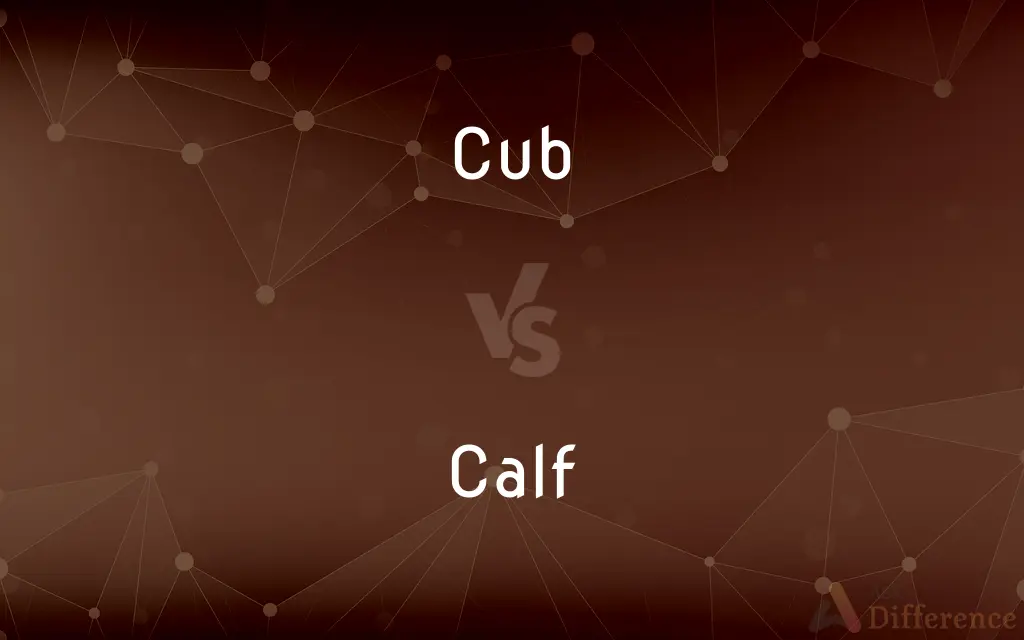Cub vs. Calf — What's the Difference?
By Maham Liaqat & Fiza Rafique — Updated on March 18, 2024
A cub is the young of certain carnivorous mammals like bears, lions, and tigers, characterized by their dependence on parents. A calf is the young of specific large mammals such as elephants, cows, and whales, noted for being the offspring of herbivores.

Difference Between Cub and Calf
Table of Contents
ADVERTISEMENT
Key Differences
Cubs are typically born in litters and are known for their playful behavior and physical dependency on their mothers for food and protection. On the other hand, calves are the young of larger mammals, often herbivores or marine giants, such as elephants, whales, and bovines. They are usually born singly and are notable for their rapid growth. Calves rely on their mothers for nourishment, which, in the case of land mammals, is often milk, while learning to navigate their environment.
While cubs enter a world where learning to hunt and camouflage is crucial for survival, calves must quickly learn to walk or swim to keep pace with their herd or pod. This difference underscores the varied survival strategies evolved by carnivorous and herbivorous mammals, respectively. In aquatic environments, whale calves must surface to breathe air from a young age, demonstrating the unique adaptations of marine mammals. In contrast, terrestrial cubs, such as lion cubs, engage in play-fighting as a way to hone their predatory skills.
The social structures of species also influence the upbringing of cubs and calves. For instance, lion cubs are raised within a pride where they interact with multiple elders and siblings, fostering a sense of community. Conversely, elephant calves grow up in tight-knit matriarchal herds, where they receive care not only from their mothers but also from other females, highlighting the communal care strategy among some herbivores.
Cubs and calves play significant roles in their respective ecosystems, with their successful upbringing ensuring the continuation of species and the maintenance of ecological balance. Their early life stages are critical for developing the skills necessary for young's life, whether that involves predation for cubs or social integration and migration for calves.
Comparison Chart
Definition
The young of carnivorous mammals like bears and lions.
The young of large mammals such as elephants and cows.
ADVERTISEMENT
Characteristics
Born in litters, playful, dependent on mother for survival.
Often born singly, rapid growth, dependent on mother's milk.
Survival Skills
Learn hunting and camouflage.
Learn to walk or swim quickly, social behaviors.
Examples
Bear cubs, lion cubs, wolf pups.
Elephant calves, whale calves, cow calves.
Social Structure
May grow up in familial or pack structures.
Often part of a herd or pod with communal care.
Compare with Definitions
Cub
A cub is the young of a predatory animal, such as a lion.
Lion cubs play near their resting mother.
Calf
A calf is the young of large mammals, such as elephants.
The elephant calf stays close to its mother in the herd.
Cub
Predatory animal families, like packs or prides, often raise cubs collectively.
Lion cubs are raised within the safety of the pride.
Calf
Mother's milk is essential for calf growth.
The cow calf feeds on its mother's milk for several months.
Cub
Cubs often rely on their mothers for food.
The bear cub followed its mother, learning to fish.
Calf
Calves typically learn to walk or swim shortly after birth.
Whale calves must surface for air soon after being born.
Cub
Play is crucial for cubs to learn survival skills.
Wolf pups playfully wrestle to strengthen hunting skills.
Calf
Calves must quickly adapt to their environment for survival.
The bison calf learns to run with the herd within hours of birth.
Cub
Cubs stay with their parents until they can fend for themselves.
The tiger cub stays with its mother for up to two years.
Calf
In herbivore herds, calves benefit from communal care.
Elephant calves are protected and cared for by all females in the herd.
Cub
One of the young of bears, wolves, lions, pandas, or certain other animals.
Calf
A young cow or bull.
Cub
A youth, especially one who is inexperienced, awkward, or ill-mannered.
Calf
One of the young of certain other mammals, such as moose, elephants, or whales.
Cub
A novice or learner, particularly in newspaper reporting.
Calf
Calfskin leather.
Cub
A young fox.
Calf
A large floating chunk of ice split off from a glacier, iceberg, or floe.
Cub
(by extension) The young of certain other animals, including the bear, wolf, lion and tiger.
Calf
An awkward, callow youth.
Cub
A child, especially an awkward, rude, ill-mannered boy.
Calf
The fleshy muscular back part of the human leg between the knee and ankle.
Cub
(slang) A young man who seeks relationships with older women, or "cougars".
Jason is only 15 and his girlfriend is 23, he's quite a cub.
Calf
A young cow or bull.
Cub
(obsolete) A stall for cattle.
Calf
Leather made of the skin of the calf; especially, a fine, light-coloured leather used in bookbinding.
Cub
Synonym of cub reporter
Calf
A young deer, elephant, seal, whale or giraffe also used of some other animals.
Cub
(furry fandom) An adolescent furry character.
Calf
A chunk of ice broken from a larger glacier, ice shelf, or iceberg.
Cub
To give birth to cubs.
Calf
A small island, near a larger island.
The Calf of Man
Cub
To hunt fox cubs.
Calf
A cabless railroad engine.
Cub
(obsolete) To shut up or confine.
Calf
An awkward or silly boy or young man; any silly person; a dolt.
Cub
A young animal, esp. the young of the bear.
Calf
(anatomy) The back of the leg below the knee.
Cub
Jocosely or in contempt, a boy or girl, esp. an awkward, rude, ill-mannered boy.
O, thou dissembling cub! what wilt thou beWhen time hath sowed a grizzle on thy case?
Calf
The muscle in the back of the leg below the knee.
Cub
A stall for cattle.
I would rather have such . . . .in cub or kennel than in my closet or at my table.
Calf
The young of the cow, or of the Bovine family of quadrupeds. Also, the young of some other mammals, as of the elephant, rhinoceros, hippopotamus, and whale.
Cub
A cupboard.
Calf
Leather made of the skin of the calf; especially, a fine, light-colored leather used in bookbinding; as, to bind books in calf.
Cub
To bring forth; - said of animals, or in contempt, of persons.
Calf
An awkward or silly boy or young man; any silly person; a dolt.
Some silly, doting, brainless calf.
Cub
To shut up or confine.
Calf
A small island near a larger; as, the Calf of Man.
Cub
An awkward and inexperienced youth
Calf
A small mass of ice set free from the submerged part of a glacier or berg, and rising to the surface.
Cub
A male child (a familiar term of address to a boy)
Calf
The fleshy hinder part of the leg below the knee.
Cub
The young of certain carnivorous mammals such as the bear or wolf or lion
Calf
Young of domestic cattle
Cub
Give birth to cubs;
Bears cub every year
Calf
The muscular back part of the shank
Calf
Fine leather from the skin of a calf
Calf
Young of various large placental mammals e.g. whale or giraffe or elephant or buffalo
Common Curiosities
Can the terms cub and calf be used interchangeably?
No, the terms are specific to the offspring of different types of animals, with "cub" referring to carnivores and "calf" to herbivores or large mammals, including aquatic species.
What is a cub?
A cub is the young offspring of a carnivorous mammal, such as a lion, bear, or wolf, often characterized by their playful nature and learning phase of hunting skills.
What distinguishes a calf?
A calf refers to the young of larger mammals, typically herbivores or aquatic animals like elephants, cows, and whales, known for their rapid early growth and dependence on maternal care.
How do cubs learn to survive?
Cubs learn to survive through play and direct teaching from their parents or pack, which includes learning to hunt and camouflage.
What survival challenges do calves face?
Calves face the challenge of quickly learning to walk or swim to keep up with their group, in addition to navigating social structures within their species.
How do carnivorous and herbivorous young differ in their early life?
Carnivorous young, or cubs, focus on learning hunting and survival tactics, while herbivorous young, or calves, prioritize rapid growth and mastering movement to stay with their herd.
What role do social structures play in the development of cubs and calves?
Social structures provide a framework for learning and protection, with cubs engaging in play within their family units for skill development and calves receiving communal care in herds for safety and social integration.
Why is maternal care important for cubs and calves?
Maternal care is crucial for providing food, protection, and teaching essential survival skills tailored to the needs of cubs and calves within their environments.
How long do cubs stay with their parents?
The duration varies among species, but cubs typically stay with their parents until they are capable of hunting and surviving on their own.
How does the upbringing of a cub differ from that of a calf?
A cub's upbringing is focused on learning predatory skills within a familial or pack structure, whereas a calf's upbringing is centered around rapid growth, mobility, and social behaviors within a herd or pod.
What is the significance of play for cubs?
Play is essential for cubs as it helps them develop the physical and cognitive skills necessary for hunting and survival.
What adaptations do whale calves have?
Whale calves are adapted to aquatic life from birth, able to swim and surface for air, reflecting the unique needs of marine mammals.
Share Your Discovery

Previous Comparison
Perception vs. Viewpoint
Next Comparison
Renaissance vs. EnlightenmentAuthor Spotlight
Written by
Maham LiaqatCo-written by
Fiza RafiqueFiza Rafique is a skilled content writer at AskDifference.com, where she meticulously refines and enhances written pieces. Drawing from her vast editorial expertise, Fiza ensures clarity, accuracy, and precision in every article. Passionate about language, she continually seeks to elevate the quality of content for readers worldwide.
















































